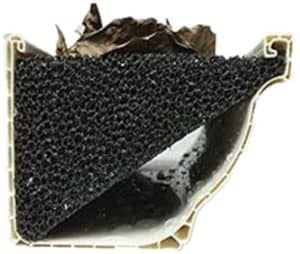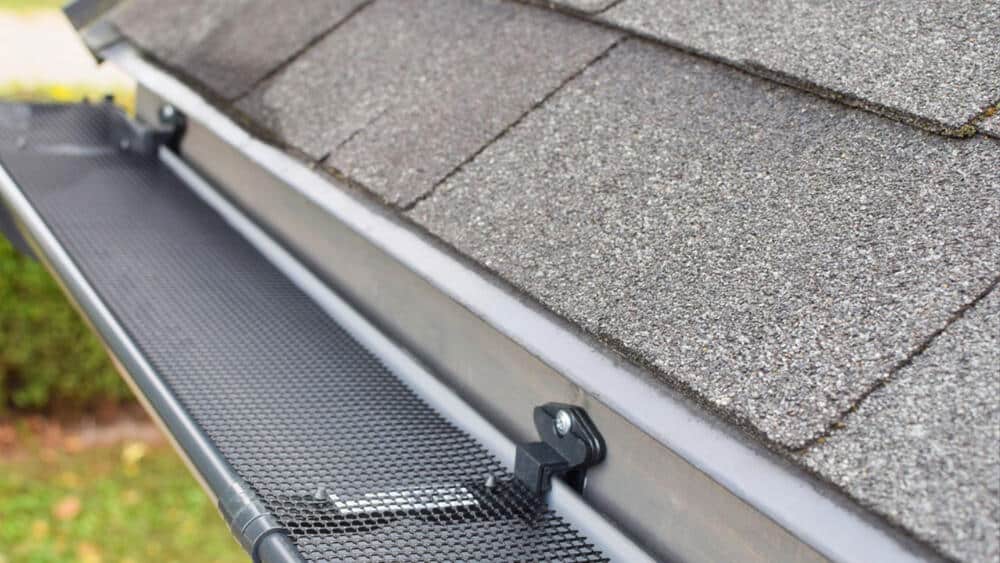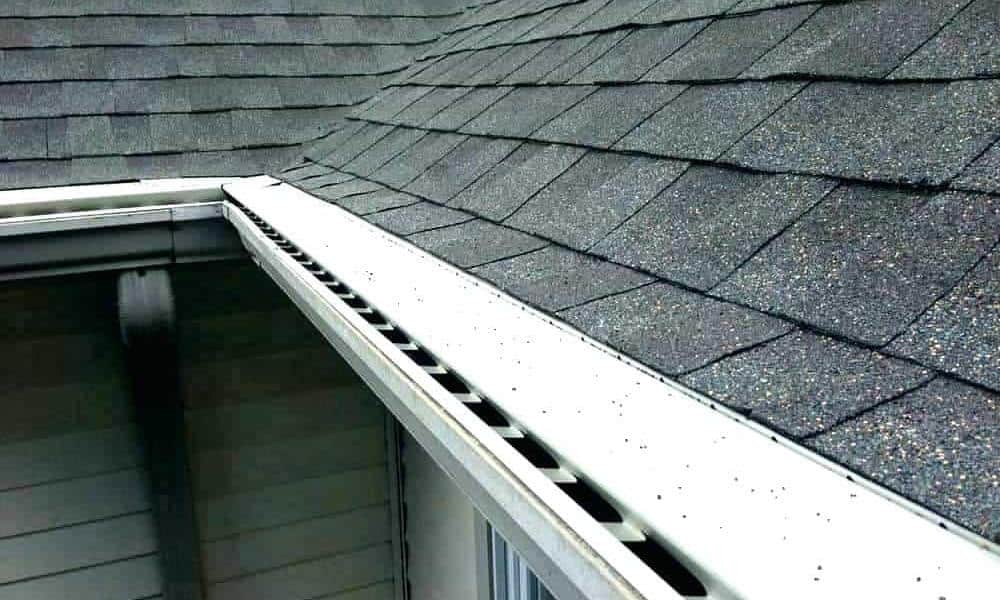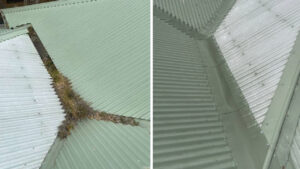Gutter guards, also known as gutter protection systems, are a great way to keep your gutters free of debris and functioning properly. They are beneficial in areas with many trees, as they can help prevent clogs caused by leaves and other debris.
So, are gutter guards easy to install? It depends. Most gutter guards are easy to install, but factors such as the gutter guard type, roof type, gutter type and accessibility can challenge a professional or DIY gutter guard installation. However, in general, the process is straightforward and can usually be completed in a few hours.
It is essential that the gutter guard is installed correctly, or you will risk defects, clogged gutters, damage to the gutter system, and issues with how the gutter guards work.
In this article, we explain how to install the different gutter guard types, the challenges of installing gutter guards and other considerations and factors.
Gutter Guard Installation
Regarding the installation process, the specifics will depend on the type of gutter guards you choose and property factors. Also, homeowners need gutter guard type has its advantages and disadvantages depending on your specific needs and roof type.
Importantly, before you instal gutter guards, make sure you clean out the gutter system; this includes gutters, downpipes and valleys. Gutter cleaning involves removing dead leaves accumulated in the gutters using a bucket. It also requires you to flush the entire guttering system with a hose.
Gutter cleanings and installing gutter guards are conducted at heights, so we cannot understate how important it is to adhere to safety at heights regulations. Here are some basic safety requirements and considerations:
- Different states in Australia have specific regulations so ensure you familiarise yourself with these before you start.
- When working at heights, ensure you have the correct safety equipment, such as ladders, scaffolding, and harnesses.
- Ensure you have the proper protective clothes, gloves, and comfortable shoes to provide grip. Also, wear protective clothing from the elements.
- Never install gutter guards in wet or freezing weather.
- Wait to install DIY gutter guards after you clean the gutters to ensure the roof has dried.
- We recommend working at heights with a minimum of two people.
- If you perceive any risk in installing a DIY gutter guard, seek assistance or professional installation.
Gutter Guard Types
First, it’s essential to understand the different gutter guards available.
Homeowners can choose several gutter guard options, including:
- Brush gutter guard
- Foam Inserts
- Mesh panels, gutter covers or screen gutter guards
- Integrated mesh systems, including micro mesh gutter guards
- Reverse curve guards or vinyl gutter guards
Brush gutter guards
Brush gutter guards, also known as gutter brushes, are a popular solution for preventing leaves, twigs, and other debris from clogging up your gutters. These gutter guards cost less than most other guards and are designed to capture small debris in their outward-facing bristles allowing rainwater to flow freely.
When it comes to installation, brush gutter guards are generally considered easy. Most systems can be installed without professional help and can be done in just a few hours.

How to install brush gutter guards
To install brush gutter guards, you need to:
- Measure the length of your gutters
- Cut the gutter guard to size with a utility knife or tin snips.
- Clean your gutters thoroughly before installing the guards.
- Once your gutters are clean and dry, sit them inside the entire gutter.
One of the benefits of brush guards is its easy DIY installation, even for those with little or no DIY experience. They can be easily cut to fit any gutter length and come with detailed installation instructions. This makes them an ideal solution for homeowners who want to keep their gutters clear of debris without the expense of hiring a professional.
Negative aspects shared by both the brush and foam gutter guards are that they require regular changing. They are also a fire hazard due to the manufactured material. This means they are not suitable in any area prone to bushfires. Foam inserts and brush guards can also make eligible homes for other pests, such as mosquitoes and birds.
Foam gutter guards
Foam guards are another popular option and are typically the easiest to install. They work by creating a barrier that blocks debris from entering your gutters, looking like pool foam noodles. These guards are usually made of foam material inserted into your gutters. They are also easy to install, as they can be cut to fit any size gutter and pushed into place.

How to install foam inserts
To install foam inserts, you will need to:
- Clean your gutters thoroughly before installing the guards.
- Once your gutters are clean and dry, push the foam guards into place.
- Cut the gutter guards to size to fill the entire guttering system.
Mesh Panels
Mesh panels, also known as mesh guards, are standard DIY gutter guards. They are made of a durable, lightweight material with perforated holes that are placed over the top of your gutters. The mesh screens allow optimal water flow while keeping leaves and other debris out. These guards are easy to install because they snap onto the lip of your gutter, making them a great DIY route.

How to install mesh gutter guards
Installing gutter guards like mesh panels requires you to:
- Clean your gutters thoroughly before installing gutter guards.
- Once your gutters are clean and dry, snap the mesh guards onto the gutter.
- Some mesh panels include support brackets that may attach to the outer edge or across the entire gutter.
Reverse curve guards

Reverse curve guards or vinyl guards are advanced gutter guards that use a curved design to force debris to fall off the roof before reaching the gutters. It is not commonly used in the Australian gutter guard industry and is more common in America. These gutter guards are more complex and may require professional installation, but they protect effectively against clogs and blocked gutters.
Installing reverse curve guards requires a particular bracket system installed on your roof. This system holds the guards in place and creates a curved design. As a result, it’s best to leave the installation of reverse curve guards to professionals.
Integrated mesh systems
The micro-mesh gutter guard works best as part of an integrated mesh system to provide more comprehensive gutter protection. An integrated mesh system may also be known as a leaf guard or gutter protection system.
It works with the roof’s pitch, creating a slope and surface tension that encourages debris and leaves to fall to the ground. It also filters the rainwater to prevent clogged gutters and block debris. The integrated mesh system is suitable for homes in areas prone to heavy downpours.
Depending on the size of your property, it usually takes about a day to install a standard single-storey home. We only recommend professional installation for homes with multiple stories.

It is the right solution for homeowners seeking bird-proofing, rainwater harvesting and bushfire protection. Aussie Gutter Protection’s TuffMesh® Emberguard is a bushfire-rated gutter guard with the smallest aperture size of 1.9 mm to prevent embers from igniting smaller debris in gutters. The ember guard also includes a water trough that ensures the surface tension does not affect the water permeability in heavy rain. Ember guard is also the best protection against fine debris like pine needles, wattles and jacarandas tree litter.
It is a more complex gutter guard installation than other DIY gutter guards, such as mesh panels, brush and foam gutter guards. However, DIY installation is easy, and many homeowners opt to get it professionally installed as it is a more long-lasting & durable solution. When installing an integrated mesh system, you must consider the type of metal roof or tiled roof and the existing gutters.

How to install integrated mesh system gutter guards
Installation to a metal roof (Trimdek®, Klip-Lok®, corrugated roofs) includes:
- Clean out the gutters
- Roll out the mesh and snip to size with tin snips
- Attach mesh to the gutter lip with trims
- Secure mesh to the roof with saddles
- Install under ridge caps
- Install gutter guard to roof valleys
Installation to a tile roof or roof shingles includes:
- Clean out the gutters
- Roll out the mesh and snip to size with tin snips
- Attach mesh to the gutter edge with trims
- Tuck the mesh under the second row of tiles or lift shingles
- Install under the ridge caps
- Install gutter guards to roof valleys.
Installing Gutter guards challenges
Some homeowners may find DIY gutter guard installation challenging due to several factors, such as box gutter installations, installation for bird proofing, ember guard, complex roof types and more.
Here are some of the most common challenges DIYers face when installing gutter guards:
- Installing gutter guards to box gutters: A box gutter is more expansive than a standard gutter system and is found in commercial and modern residential architecture. If the gutter guard does not cover the entire gutter, small and large debris will slip through the guard and cause blocked gutters. Box gutter installations require the right gutter guard that does not sag when it spans a broader gap. An integrated gutter guard keeps the mesh tight, and the slop encourages the leaves and debris to fall to the ground rather than sit on top of the guard.
- Installing gutter guards to parapets: Like a box, gutter parapets usually span gaps wider than 750mm. It requires professional installation using spanning techniques and a commercial-grade gutter guard for added strength.
- Complex fixtures: In some homes, leaves, twigs and debris accumulate in other gaps and areas in the house. Professional installers can install gutter guards from roof-to-roof, roof-to-wall, and roof-to-bull nose gutters, keeping debris off the roof areas.
- Multiple storeys: Installation across numerous storeys is challenging and dangerous. We recommend seeking professional installers for any project above two levels.
- Bird proofing: Many DIY gutter guards do not protect birds and pests from nesting in your gutters and roof. A 100% bird-proofing solution requires an installer to locate and cover all areas where birds can access your home spaces.
- Ember guard: Ember guard is a speciality product that meets strict requirements for homes in Bushfire attack level (BAL) rated areas. To meet ember guard specifications, the mesh hole size must be a minimum of 2 mm to prevent embers from igniting smaller debris in gutters. It also must be made of aluminium for up to BAL29 ratings or bronze or Colorbond® steel for extreme BAL40 and FZ ratings. Not all stainless steel gutter guards meet ember guard specifications. There are also installation considerations that can make applications a challenge.
Professional gutter guard installation
In conclusion, most gutter guards are easy to install. Some are more easily installed than others. However, those gutter guards tend to be less durable solutions. Both guards are simple to install and can be completed by DIYers with minimal experience.
Hiring a professional is best to ensure the job is done correctly if you install reverse curve guards or integrated mesh gutter guards. Gutter guards are a great way to keep your gutters functioning properly and can save you time and money in the long run.
Frequently Asked Questions
Can a homeowner install gutter guard themselves? Legally yes, but safe height work, correct trim angles and the AS 3959 ≤ 2 mm gap rule make DIY challenging.
What tools are required to install gutter guard? Extension ladder with stabiliser, tin snips, cordless rivet gun, colour-matched screws, safety PPE.
How long does a typical install take? Experienced two-person crews finish an average single-storey home in ~6 hours; DIY often stretches into two weekends.
What’s the advantage of professional installation? Correct fit first time, colour-matched trims, full safety compliance and transferable 20-year workmanship guarantee.
Do professionals clean gutters first? Yes, every AGP job starts with a gutter vacuum and flush before mesh goes on.
Aussie gutter protection is a leader in the gutter guard industry, working with high-quality materials; products GutterMesh, TuffMesh, SteelMesh and SolarMesh; installation methods for leaf guard, bird proofing, rainwater harvesting, bushfire prevention and solar panel protection. AGP offers professional installation at affordable pricing to keep your gutters clean and ensure rainwater flows freely. Get a free consultation that brings you one step closer to ridding yourself of clogged gutters.








